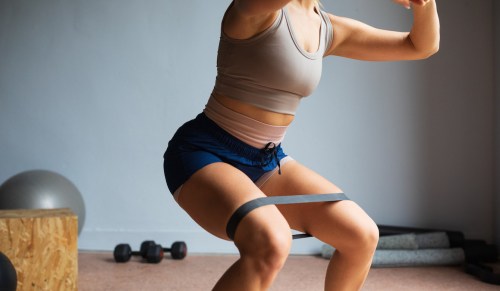Sometimes hip pain, which can also lead to back and knee pain, is the result of your muscles becoming tight and shortened and your joints shifting. Yes, it sounds extreme, but our joints and muscles tend to do their own thing as they get tight and stiff. Case in point: the hip flexors and quadratus lumborum (QL), are often the culprit behind your hips and pelvis shifting, which can result in hip pain.
Experts in This Article
board-certified orthopaedic physical therapist, certified early intervention specialist, and owner of Marko Physical Therapy
Why your hips tend to shift into different positions
“When the hip flexors become tight they pull on the pelvis and rotate the pelvis slightly forward into an anterior pelvic tilt,” says Theresa Marko, PT, DPT, MS, board-certified clinical specialist in orthopedic physical therapy. One of the easiest ways to tell if you have an anterior pelvic tilt is if there’s an arch in your lower back or lumbar spine, your glutes stick out, and your ribs protrude forward.
Because this tilt takes your spine out of a neutral position, the tension tends to pull on the joints of your pelvis, typically at the sacroiliac joint, commonly referred to as the SI joint. If you place your hands on your hips and press your thumbs into the area below your vertebrae and above your tailbone, you’ll feel your SI joint. “It is here that one might start to feel pain and possibly some nerve pain down their leg manifested in feeling a tingle or numbness,” explains Dr. Marko.
Another muscle that can contribute to a shift of the pelvis or hips is the QL. According to Dr. Marko, this muscle is the powerhouse of the body and helps stabilize the lumbar spine, in addition to helping the pelvis and hip move during activities such as walking. But it can often become tight and get stuck in a shortened position. Similar to what happens when the hip flexors get tight and shorten, this can pull your pelvis up, says Dr. Marko, leading to lower back or lumbar spine pain and nerve pain down the leg.
For those who tend to go from zero to 100 when it comes to diagnosing pain, there’s no need to worry, your joints aren’t dislocated. They’ve simply temporarily shifted into a different position, says Dr. Marko. The good news is, it’s possible to fix this shift and get them back in the optimal position.
How to tell if your hips or pelvis have shifted positions
Oftentimes you’ll have an inclination that your hips or pelvis have shifted if you’re experiencing pain at the SI joint. Depending on how in-tune you are with your body, you may also feel like one leg is longer than the other (this is caused by the shift of the pelvis), says Dr. Marko.
“I would say the easiest way to check your pelvis is to lie on the floor with your legs bent, put your hands on top of your pelvis and try to feel if one [side] is higher than the other. If so, then your QL is tight on the higher side,” explains Dr. Marko.
You can also straighten your legs and have someone look at the bones on the inside of your ankles to see if they’re level. If they aren’t level, one of your hip flexors is more than likely tight, causing the imbalance.
How to get your hips and pelvis back in the proper position
There’s no need to panic if your hips or pelvis have shifted and aren’t in the optimal position. “This is a completely normal position that the body can move into and thus it can move out of it as well,” says Dr. Marko. But to get them back into the proper position and alleviate any discomfort and pain you may be experiencing, Dr. Marko recommends trigger point release of the iliopsoas and iliacus (your hip flexors), stretching your hip flexors, and working on strengthening your glutes.
Strengthening your glutes will help to prevent your hips and pelvis from shifting because they help to prevent tight hip flexors, allowing you to fully extend the hip and rotate the pelvis posteriorly, says Dr. Marko.
Targeting your QL is a bit more challenging and requires help from an expert, such as a physical therapist to release it. But, in the meantime, Dr. Marko recommends strengthening the lateral hip stabilizers and glute medius so that the QL muscle isn’t overworking and in order to naturally loosen it.
One simple movement that works on all of the above is the traditional glute bridge—it can help get your hips and pelvis in the proper position in no time. If you’re experiencing discomfort and pain for an extended period of time, Dr. Marko recommends working with a physical therapist who can create a custom treatment plan for you.
If your hips are extremely tight, try this 24-minute yoga flow to loosen them up:
Oh hi! You look like someone who loves free workouts, discounts for cutting-edge wellness brands, and exclusive Well+Good content. Sign up for Well+, our online community of wellness insiders, and unlock your rewards instantly.
Sign Up for Our Daily Newsletter
Get all the latest in wellness, trends, food, fitness, beauty, and more delivered right to your inbox.
Got it, you've been added to our email list.











